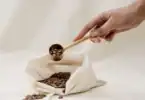Salt is about 40% Sodium and 60% Chloride. Dietary guidelines care about how much Sodium we have in our diets, but what does that mean?
People in the US tend to think about culinary salt in terms of volume: a teaspoon or 1/4 of a teaspoon. In Europe, most of the recipes list salt quantities by weight in grams or milligrams. When pickling or curing, the amount of salt is critical to the process, so having a more precise idea of how much salt need to be added makes the difference between moldy pickles or crisp delicious pickles.
Throw into this confusion the fact that different salt has different amounts of sodium per volume. Even different brands of kosher salt can have widely different amounts of sodium in a teaspoon. Finely ground salt may weigh more per teaspoon than medium grain or coarse grain salt.
Confused yet? I was! So when I couldn’t find a good chart to show Salt Sodium Content between different types of salt, I made my own. I share my Salt Comparison Guide with you in this article.
Salt Sodium Content Factors
The factor that contribute most to the sodium content of different types of salt is Density. Density is essentially how much does something weigh as compared to how much space does it take up (volume). Grain size contributes to this: finely ground salt fits closely together and coarsely grained salt has air pockets between the grains when measuring in a teaspoon.
Different brands produce their salt using different methods, so Kosher salt with the same grain size can have quite different weights for the same amount of volume. This is because the salt within each grain is more or less dense than other brands.
The source of the salt actually makes less difference than you would think. A teaspoon of finely ground Himalayan salt or a medium grained Hawaiian Sea Salt have very similar weights to common table salt. So on to our table so that you can compare salt sodium content between types and brands.
Salt Comparison Guide
| Salt Type | mg Sodium per 1/4 tsp | mg Weight per 1/4 tsp | Grain Size | Brand providing Nutrition Facts |
| Table Salt | 590 | 1500 | Fine | Morton’s |
| Himalayan | 590 | 1500 | Fine | Sherpa Pink |
| Himalayan | 380 | 1000 | Coarse | La Sal Co |
| Kosher | 280 | 700 | Medium | Diamond Crystal |
| Kosher | 390 | 1000 | Medium | Manischewitz |
| Kosher | 480 | 1200 | Medium | Morton’s |
| Sea Salt | 280 | 700 | Finishing crystals | Maldon |
| Sea Salt | 450 | 1500 | Small | Baja Gold |
| Sea Salt | 460 | 1500 | Small | Celtic Sea Salt |
| Sea Salt, Iodized | 530 | 1300 | Fine | Morton’s |
| Pickling Salt | 590 | 1500 | Fine | Morton’s |
| Sel Gris | 351 | 1000 | Small | Esprit du Sel |
| Hawaiian Sea Salt (white or Alaea Red) | 590 | 1500 | Medium | Old Time |
| Redmond’s Real | 530 | 1400 | Fine | Redmond’s |
How to Use this Salt Comparison Guide
Now maybe you are thinking “Okay, that’s interesting, but what does it really mean to me?” Here are some areas in your life where knowing that different salts have different amounts of sodium might change how you are using salt.
Salt Comparison Guide for Dietary Health
The recommended daily allowance of Sodium in your diet is considered to be 2300mg. The American Heart organization would like to see people lower that to 1500mg. They discuss that in this article: How Much Sodium Should I Eat a Day. I also have written an article on this subject, Your Diet: How Much Salt is Too Much Salt? that goes into related salt vs. sodium topics and contains a number of Frequently Ask Questions about salt consumption, such as whether to salt the pasta water and more.
So for table salt, 2300mg is a bit less than a teaspoon. If you only used Diamond Crystal Kosher salt in your diet, 2300mg would be more like two teaspoons. Of course, many foods that we eat every day from bread to salad dressing, and especially highly processed foods like chips or cookies contain Sodium.
So having this salt sodium content guide just helps inform you about the relative differences between the salts you may use at home for preparing foods and for salts you have on your table for consuming foods.
Salt Comparison Guide for Baking
Even though more and more recipes are starting to provide salt quantities as both volume and weight, many of the recipes I use came from my grandmother or at least pre-date this trend. Recipes online are also starting to call out the kind of salt, but as you can see from the salt comparison guide, knowing that you should use kosher salt still doesn’t tell you exactly how much sodium that is, unless you also know the brand.
Thankfully, the cookie recipe that calls for 1/2 teaspoon of salt is not going to be ruined by a bit too much or too little salt. In many recipes it is best to start with a smaller amount of salt, and then “adjust to taste”.

Salt Comparison Guide for Pickling
Successful picking requires an accurate amount of Sodium. Why? Because having too little salt will allow bacteria to form, resulting in moldy and mushy vegetables. Adding too much salt will prevent the good bacteria (lactic acid) from forming, so all you will have for your efforts are old veggies sitting in very salty water. However, if you have just the right amount of Sodium, you will get perfect pickles every time.
Most people just follow a recipe or use a brine chart, and things may work out fine. Or not. If the amount of vegetables vary or the type of salt varies, you may get inconsistent results. For perfect pickles, the salty brine needs to be about 2.5% salt BY WEIGHT as compared to the weight of the vegetables plus the water in each container.
Most recipes have you make about a 3% salt brine ahead of time, and then you pour it into several different containers. Containers with more veggies will end up with a lower salt concentration than containers with fewer veggies. Even if you fill up each of your jars consistently, you are not sure if enough brine will fit in the jar to bring the concentration to the right level.
Instead, you need to weigh each container to determine how much it weighs, then add the correct amount of salt to achieve a 2.5% salt concentration. To do this, you need a fairly accurate digital kitchen scale, and you need to know what kind of salt you are going to use.
- Set up your kitchen scale. Set the Units to read out in Grams (g)
- Put an empty canning container on the scale and use the Tare to make the scale show ‘0’ when the container is on it.
- Remove the container – you will see a negative number
- When you mix up your pickling liquid, add everything except the salt: vinegar, sugar, water, spices, herbs, etc.
- Now place a canning container back on the scale that contains your vegetables and enough of the pickling liquid mixture to cover them.
- Record that number on the scale. You are going to multiply that number by .025 to get the amount of salt in grams (g) that is needed for that jar.
- If you have an accurate enough scale, you could just weigh out that much salt. Many of the digital kitchen scales on the market are accurate to 0.1 grams, so this is enough accuracy for just weighing your salt.
- If you don’t have a scale that is accurate enough, you are going to have to do math. Look at the label on your Pickling salt, or whatever kind of salt you are using and figure out how many grams are in a level teaspoon.
Real life example #1: I fill up a quart jar with cucumbers and pickling liquid (spices, vinegar, water, but NOT salt). I weigh it and the number on my scale is 840 grams. 840 multiplied by .025 is 21 grams. The salt I’m using is Diamond Crystal Kosher salt, so I look at the Salt Comparison guide above (or the label on the salt container) and see that it says there are 700 mg in a 1/4 teaspoon (2.8 grams in 1 teaspoon). 21 grams divided by 2.8 is 7.5 teaspoons. Since there are 3 teaspoons in a tablespoon, that means I need to add 2.5 tablespoons of my salt to the jar. Be sure to shake well after sealing the jar to make sure the salt dissolves.
Real life example #2: I fill up a quart jar with cucumbers and pickling liquid (spices, vinegar, water, but NOT salt). I weigh it and the number on my scale is 840 grams. 840 multiplied by .025 is 21 grams. The salt I’m using is Morton’s Picking salt, so I look at the Salt Comparison guide above (or the label on the salt container) and see that it says there are 1500 mg in a 1/4 teaspoon (6 grams in 1 teaspoon). 21 grams divided by 6 is 3.5 teaspoons. Since that is just a little over a tablespoon, it’s probably better to measure using my teaspoon measures to get an accurate amount.

If you have a recipe for a single jar of pickles, and it gives exact sizes for the jar, and the type of salt they used, things might work out. If any of the measurements or type of salt is vague, you will have better results through weighing and careful measurement of your salt.
For more about comparing Himalayan salt to Pickling salt, as far as flavor profiles go (rather than just sodium content), please see our article: Pickling Salt Vs. Himalayan Salt: What’s The Difference? If your interest is learning about different kinds of food preservation that is assisted by salt, see the article: Can Himalayan Salt Be Used for Pickling, Curing, and Fermenting. For more about the different types of salt that we list in our guide (plus other salt terminology) see: Worth It’s Salt: 20 Different Types of Salt.
What is the Best Salt for Dietary Health?
There are many factors that go into selecting a salt, including flavor, form (flakes, grains, crystals), trace elements, availability and price. From a standpoint of picking salt for maximizing tasty salt flavor while minimizing overall salt consumption, these are my top two picks:
- Maldon Salt – for finishing
- Diamond Crystal Kosher Salt – for baking and food preparation
Both of these salts appear in the Sodium Comparison table above, and you will see that they are lower Sodium content per volume choices. If you are unfamiliar with these salts, please check out the links below for samples of each.
This is a 240 gram (about 8.5 ounce) package of Maldon salt. It comes in the traditional (and recyclable!) green box.
3 pounds of Kosher salt: Diamond Crystal is enough of a kitchen staple that it gets specified in recipe books. This multi-purpose salt can be used for baking, meal preparation, food preservation and in a grinder for sprinkling on top of foods.
Final Thoughts
I hope that my Salt Comparison guide is useful enough that you’ll bookmark this page! I certainly learned a lot about my favorite salts as I examined all of the nutritional labeling. Whether the purpose of your visit was health, better baking or perfect pickles, I wish you the best salting experiences!
Pickle Photos by Eva Bronzini.









